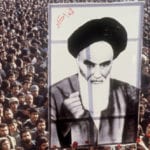 Music
Music  Music
Music  History
History 10 Less Than Jolly Events That Occurred on December 25
 Weird Stuff
Weird Stuff 10 Funny Ways That Researchers Overthink Christmas
 Politics
Politics 10 Political Scandals That Sent Crowds Into the Streets
 Weird Stuff
Weird Stuff Ten Bizarre Facts About The Doge Meme
 Our World
Our World 10 Ways Your Christmas Tree Is More Lit Than You Think
 Movies and TV
Movies and TV The 10 Coolest Stars to Set Sail on The Love Boat
 History
History 10 Things You Didn’t Know About the American National Anthem
 Technology
Technology Top 10 Everyday Tech Buzzwords That Hide a Darker Past
 Humans
Humans 10 Everyday Human Behaviors That Are Actually Survival Instincts
 Music
Music 10 Surprising Origin Stories of Your Favorite Holiday Songs
 History
History 10 Less Than Jolly Events That Occurred on December 25
 Weird Stuff
Weird Stuff 10 Funny Ways That Researchers Overthink Christmas
Who's Behind Listverse?

Jamie Frater
Head Editor
Jamie founded Listverse due to an insatiable desire to share fascinating, obscure, and bizarre facts. He has been a guest speaker on numerous national radio and television stations and is a five time published author.
More About Us Politics
Politics 10 Political Scandals That Sent Crowds Into the Streets
 Weird Stuff
Weird Stuff Ten Bizarre Facts About The Doge Meme
 Our World
Our World 10 Ways Your Christmas Tree Is More Lit Than You Think
 Movies and TV
Movies and TV The 10 Coolest Stars to Set Sail on The Love Boat
 History
History 10 Things You Didn’t Know About the American National Anthem
 Technology
Technology Top 10 Everyday Tech Buzzwords That Hide a Darker Past
 Humans
Humans 10 Everyday Human Behaviors That Are Actually Survival Instincts
10 Modern-Day Heroes Actively Changing The World
As children, we all had our favorite superheroes. We loved them, worshipped them, pretended to be them, dressed like them and even talked like them. Now that we’re adults, we are all well aware that heroes are in high demand but can rarely be found. The overwhelming ugliness and depravity found everywhere in the world today, has desensitized us to the point where hardly anything seems shocking or repulsive anymore.
SEE ALSO: 10 Outrageous Real Life Superheroes
Luckily we don’t need superpowers or a cape to make a difference in the world. To accomplish heroic acts, all we need is a willing mind and a willing heart. Many of the courageous, self-sacrificing people on this list were nominated as CNN heroes. They have all proven that an ordinary person can achieve extraordinary feats and make a difference in the lives of others.
10
The absence of clean water and its consequent illnesses kills more children every year than HIV/AIDS, malaria and tuberculosis combined. These and other water crisis statistics encouraged Hendley, who was working as a barman, to raise money by pouring wine to promote and support water projects worldwide. As of 2004 his non-profit organization, Wine to Water, has worked in Sudan, India, Cambodia, Uganda, Ethiopia, Peru, South Africa and Kenya and they have implemented sustainable drinking water initiatives for thousands of people. The organization also responded to the 2010 Haiti earthquake by implementing water purification systems in the disaster areas. The organization also provides training to local workers in installing water purification systems, digging, maintaining wells, and more. To date they have dug hundreds of wells in Cambodia, Africa, and Peru—always making use of local workers to stimulate the economy.
9
Jorge Muñoz arrived in America as an illegal immigrant in the early ’80s. He became a citizen in 1987. One evening as he left a bar he noticed all the destitute and illegal day laborers and the flame in his heart was lit. He found out that most of the men sleep under a bridge or in the Elmhurst Hospital’s emergency room and skimped on meals in order to send money to their loved ones at home. Since then, he has been cooking enough food to feed dozens of day laborers in Queens which he delivers at the corner of Roosevelt Avenue and 73rd Street in Jackson Heights every evening at 21:30. Munoz delivers the warm, cooked meals in rain, snow, thunder, and lightning. He estimates that he has served food to more than 70,000 people since 2004. The whole operation is financed from the $600 he receives weekly for driving a school bus and donations. On August 4, 2010, Munoz was awarded the Presidential Citizens Medal by President Barack Obama.
8
Aki Ra was a very young boy when he was chosen by the Khmer Rouge to become a child soldier. He laid thousands of mines and fought for the Khmer Rouge until 1983. During his time in the Cambodian army he received landmine clearance training with the United Nations and heard his true calling. Without any demining tools, he started to illegally clear and defuse mines and UXO’s in the areas he had fought with nothing but a knife, Leatherman and a stick. As his name and work became known, tourists flocked to his home to see the collection of defused artillery. Charging a dollar per person the Cambodia Landmine Museum came into being. To open the museum, Aki Ra had to cease his illegal clearing of the mines, but was able to establish a NGO—Cambodian Self Help Demining (CSHD)—and he is now certified to do his life’s work. Over the course of time, Aki Ra also adopted many of the injured and abandoned children he found in the villages he visited. Today, 29 children live at the Cambodia Landmine Relief Center.
7
Pushpa Basnet was an undergraduate in Social Work when she had to visit a female prison in Kathmandu as part of a college assignment. The sight of the prisoners’ children living behind bars along with their mothers urged her on to raise enough money to start The Early Development Center (ECDC) and Butterfly Home. These non-profit organizations provide a day-care program to the children and are a residential home for the older children to live in throughout the year. Pushpa’s organizations also aid and provide these children with school enrollment, meals, and medical care. As of 2009 she is also teaching the incarcerated women handcrafts so as to enable them to generate an income to contribute towards raising their children. To date she has assisted more than 100 children.
6
Eugene and Minhee Cho have always been aware of the imbalances in the world. It was only when they started traveling and saw with their own eyes the “faces” of the people living in extreme poverty, that they founded One Day’s Wages—A non-profit organization based on the principal of donating one day’s wages to uplift and enable those in need. In 2009 they donated their entire yearly income to their cause just to let people know they wouldn’t ask something of others if they weren’t willing to do it themselves. To date, they have funded over 40 projects and in doing so have given nutritional support, provided HIV treatment and care, improved access to maternal care, provided clean water, funded lifesaving heart surgeries and provided an education to hundreds of individuals globally.
SEE ALSO: Top 10 Superheroes Who Struggle With Mental Health
5
Narayanan Krishnan was an award-winning chef on his way to a very bright future when the sight of an old and destitute man eating his own human waste out of hunger put his life on a different course. He quit his job during the next week and within a year he had founded the Akshaya Trust, which feeds and take care of the destitute and mentally disabled people in Mandurai, Tamil Nadu. He prepares and serves three warm and fresh vegetarian meals every day, which he often hand feeds to the people that he seeks out under bridges and other desolate and abandoned spots. Krishnan also carries a comb, scissor and razor with him to provide extra dignity to those he cares for. Today, Krishnan sleeps in Akshaya’s kitchen along with his co-workers, he has no income and scrapes by with the support of his parents. To date he has served more than 1.2 million meals to India’s destitute.
4
Whilst traveling in India in 1979, Marc Gold met a woman suffering from a terrible ear infection. He paid $1 for her antibiotics and a further $30 for a hearing aid that restored her hearing. It was at that moment that he came to the realization that you can do a lot with almost nothing. On his arrival back home, he sent letters to 100 friends and asked for donations he could use during his next trip. To date, Marc has been on 22 missions in 67 countries; he has raised nearly $600,000 and has purchased everything from bicycles and rice to sewing machines, schools, and mosquito nets. As founder and director of the 100 Friends Project, he simply goes looking for problems in the slums, at hospitals, clinics and orphanages. His only request is that recipients give back by helping others.
3
In 1984 Dr. Rick Hodes went to Ethiopia to do relief work during the famine. He originally planned on working there for one year, but after realizing the African people’s extreme needs and knowing that he was uniquely qualified to help them, he stayed. After almost three decades, he still practices at hospitals in Addis Ababa and Gondor. He has served tens of thousands of people through immunization, family planning, community health, nutritional support and his specialist field—spine deformities. He was also partly responsible in ensuring the safe immigration of 14,000 Ethiopians via a historic airlift to Israel in 48 hours. His greatest passion however, remains to volunteer at Mother Teresa’s Mission for the Destitute and Dying where he cares for critically ill children that others have abandoned. During his time in Ethiopia he has adopted five children and he also supports and houses another fifteen whom he sees as part of his extended family.
2
Raped at the age of six and orphaned by the age of nine, Betty Makoni somehow managed to stay strong, survive and put herself through school by selling fruits and vegetables. In 1999 she founded the Girl Child Network (GCN) in response to Zimbabwe’s pandemic of child sexual abuse, especially that of young girls. Her organization is spread over 35 of Zimbabwe’s 58 districts. She has clubs at schools that informs girls and encourages them to speak out and report on abuse. She has also built three “empowerment villages” or homes for abuse victims whom she feeds, provides with medical care and educates. She has fought against the exploitation and abuse of girls at the highest levels of society, in the process becoming a target of state harassment and receiving many death threats. To date, Betty has saved more than 7,000 (some estimates say as many as 35,000) girls from abuse, child labor, forced marriages, human trafficking and sexual assault.
1
According to the United Nations, there were 185 documented attacks on schools and hospitals in 2012 by armed groups opposed to girls’ education. According to Razia Jan, she hears about girls attacked with acid or being poisoned every single day. Despite the threats, she opens the doors of her Zabuli Education Center every school day. In this 2-story, 14-room building, 354 girls from the surrounding seven villages are receiving a free education. To keep students safe, Razia’s school is surrounded by a stone wall, there are guards and staff that open and inspect classrooms every day to check the air and water quality. They are so scared of poisoning that children are accompanied to the bathrooms to make sure they do not drink tap water. At the Zabuli Education Center, one year’s tuition fees per girl are $300. Razia covers the school fees through donations made to her non-profit organization, Razia’s Ray of Hope, based in the USA.
SEE ALSO: 10 Consequences Of Being A Superhero In Real Life
Hestie lives in Pretoria, South Africa. She is in absolute awe of the people on this list and the work that they do.








